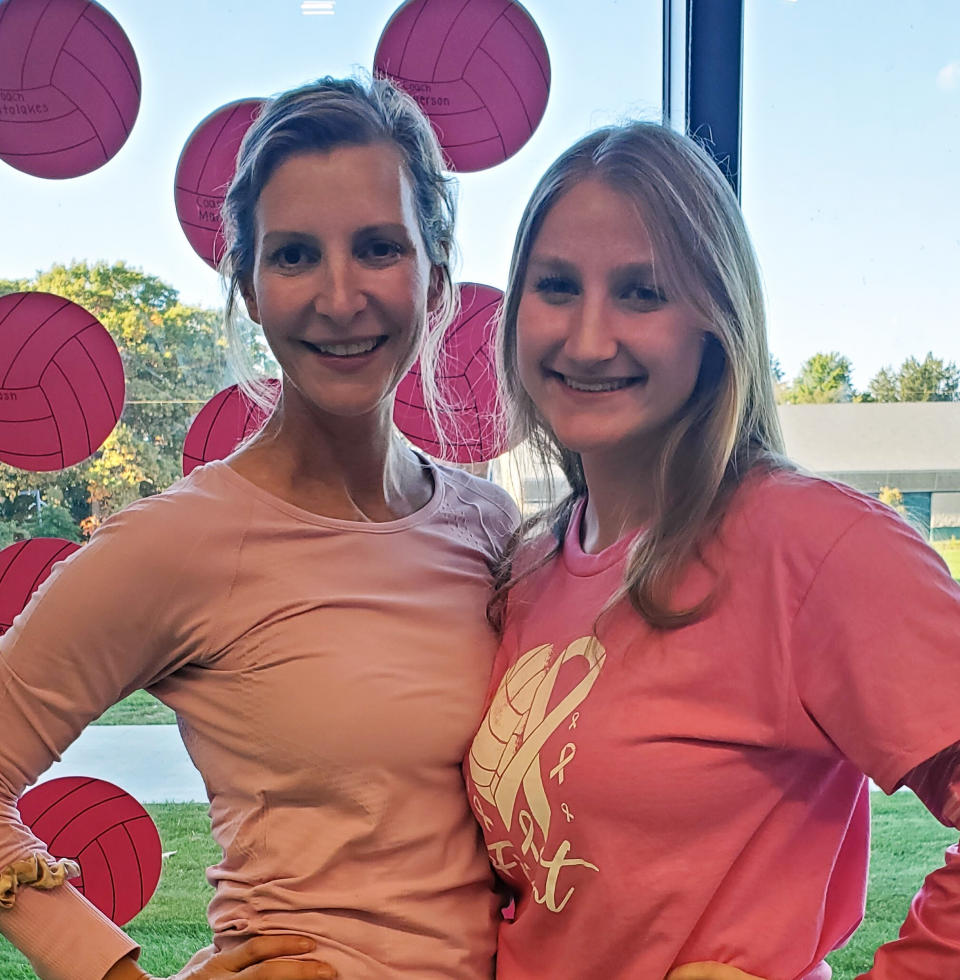Girl, 14, had 'never-ending headache.' Tests reveal potentially deadly brain condition
For much of the early part of 2022, Greta Tucker, then 14, experienced terrible headaches.
“It was really impacting school and especially sports,” the now 15-year-old from Billerica, Massachusetts, tells TODAY.com. “It was way more intense than a normal headache. … It was a never-ending headache. I’d have it when I would go to bed, when I would wake up. Advil, Tylenol, that didn’t work.”
Mom Sue Tucker felt worried, and they visited the doctor. That’s when they learned Greta had an arteriovenous malformation (AVM), a jumble of veins nestled in her brain. These congenitally malformed veins can be deadly if they rupture.
“Thankfully, there was no bleeding on the brain,” Sue Tucker tells TODAY.com. “I was a nervous wreck because I didn’t know if she could have an aneurysm at any moment.”
Headaches lead to accidental finding
At first, Sue Tucker wondered if she was worrying too much about Greta’s headaches. The teen had recently started a new medication, and severe or continuing headaches are a rare side effect of the drug. But the headaches impacted much of Greta’s life. She plays volleyball, softball and ice hockey, and the pain often left her on the bench.
“I had trouble sleeping,” Greta says. “I had to sit out of sports games and everything, and it sucked, getting to watch everyone else play and watch people take my spot.”

Sue Tucker took Greta to the doctor.
“(The pediatrician) told us that we needed to get in touch with a neurologist,” she says. “I went with (Boston Children's Hospital) and brought her to see a doctor there. That person ordered an MRI.”
Doctors determined that the medication was causing the headaches, but the MRI picked up an “incidental finding,” the AVM.
“I cried a lot,” Sue Tucker says. “We were very lucky in many ways that she did get the headaches. ... It’s not a good thing obviously. But we would have never known she had this AVM.”
Worried, Sue Tucker and her husband stopped Greta from playing sports until they better understood what having an AVM meant. Greta underwent an angiogram to help doctors better understand where the AVM rested in the brain.
“You hope that it’s closer to the outside, or the outer brain, but hers it literally right next to the inner brain in that middle part, which was near her speech function, as well as her mobility,” Sue Tucker explains. “There was a high chance if they were to surgically do anything that she could end up not being able to speak or paralyzed.”
AVMs
An AVM occurs when blood vessels in the brain form incorrectly in developing babies and then blood flows through them abnormally, says Dr. Edward Smith, one of Greta’s doctors. Experts believe they occur in one in every 10,000 people, but it could be more, he adds.
Most people with AVMs are unaware they have one but discover it like Greta did — through an MRI for another reason. AVMs often rupture without people even knowing they have one.
“They have blood flow through them in a way that isn’t normal and that puts wear and tear on them, like driving on a bad tire,” Smith, vice chair of the department of neurosurgery and co-director of the Cerebrovascular Surgery and Interventions Center at Boston Children’s Hospital, tells TODAY.com. “The scary thing about AVMs is you can be going about your daily life and everything’s fine. And then if they bleed, they’re very, very scary.”
AVMs aren’t associated with many symptoms to help people find them before they rupture.
Symptoms of AVMs can include:
Headache with vomiting or neurological symptoms
Seizure
Headache that wakes one from sleep in the morning
Smith stresses that most headaches aren’t a sign of worrisome neurological conditions.
Half to 80% of people get headaches at least once a month, Smith says. “Scary headaches are the ones people should worry about. If it’s really severe, meaning you’re crying in agony or your child is, (talk to a doctor).”
Between 12 to 25% of bleeding AVMs are fatal, he notes.
“They’re really one of the most scary things we see in medicine and neurosurgery,” he says. “What’s lucky for Greta is that it was found before it had ruptured.”
That meant that doctors could “proactively” address the AVM before Greta experienced problems. While doctors take several approaches to treating them, surgery is often the go-to, which Smith describes as “disarming a bomb.” But for patients like Greta, brain surgery is too risky. She had stereotactic radiosurgery, “a fancy way of saying really really … targeted radiation.”
“One (radiation) beam is very low intensity, so as it zaps through the healthy brain to get to the AVM, it’s not going to cause as much damage as all 10 or 20 or hundreds of beams converging at the same time,” Smith says.
This focused radiation then causes AVMs to “shrivel up” so blood no longer flows through them, and the risk of bleeding is eliminated. It can take up two or three years for the radiation to completely inactive the AVM.
“There’s the risk of bleeding in between when you get the zap and when it finally shrives up,” Smith says.
“There’s also research to show that there’s not much that triggers these to bleed,” he adds. “Typically, they bleed because there is wear and tear on the vessels, which is a time-dependent thing, and not so much if you bang your head or lift weights.”
While AVMs sound scary, Smith wants to reassure people that they are uncommon.
“These are very, very rare,” he says. “People shouldn’t freak out if they have a headache.”
Back in the game
Greta was fitted for a metal mesh mask that would go on her head and was secured to a table to make sure the radiation went in the exact spot to target the AVM. The procedure took about 15-minutes, and she was done.
“She was so awesome through the whole thing,” Sue Tucker said. “She did whatever it took. She never complained.”

While she cried a bit when she first learned she had the AVM, Greta didn’t feel frightened during treatment.
“I felt totally safe,” she says. “If something went wrong, (doctors) are right there.”
Since undergoing stereotactic radiotherapy, Greta has returned playing sports.
“Hockey, that’s my main thing. I did pretty good this season,” she says. “I just got out of softball, and I had a pretty good season, too.”
Greta's parents feels grateful that they found her AVM and were able to treat it before anything bad happened.
“We were lucky because it was an incidental finding,” she says. “I’m very thankful for that.”
She encourages other parents to advocate for their children, especially if something seems off.
“Don’t be afraid to go to the doctor,” Sue Tucker says. “If it turns out to be nothing, then that’s awesome.”
This article was originally published on TODAY.com

